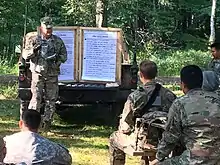After-action review
An after action review (AAR) is a structured review or de-brief (debriefing) process for analyzing what happened, why it happened, and how it can be done better by the participants and those responsible for the project or event.[1] After-action reviews in the formal sense were originally developed by the U.S. Army.[2] Formal AARs are used by all US military services and by many other non-US organizations.[3] Their use has extended to business as a knowledge management tool and a way to build a culture of accountability.[4]
An AAR occurs within a cycle of establishing the leader's intent, planning, preparation, action and review.[5] An AAR is distinct from a de-brief in that it begins with a clear comparison of intended vs. actual results achieved.[1] An AAR is distinct from a post-mortem in its tight focus on participant's own action; learning from the review is taken forward by the participants.[6] Recommendations for others are not produced. AARs in larger operations can be cascaded in order to keep each level of the organization focused on its own performance within a particular event or project.[6]
Formal AAR meetings are normally run by a facilitator, and can be chronological reviews or tightly focused on a few key issues selected by the team leader.[6] Short cycle informal AARs are typically run by the team leader or assistant and are very quick.[6]
After action reviews in the military
There are basically two types of military AARs—formal and informal. Formal AARs require more detailed planning, preparation, and resources. They are normally scheduled and conducted as a part of external and internal evaluations.[7] Informal AARs require less planning and preparation than formal AARs and are often on-the-spot reviews of soldier and collective training performance at crew, squad, or platoon level.[8]
Formal
Formal AARs are normally conducted at company level and above.[9] However, when a training event is focused at squad or platoon level, and resources are available, a formal AAR may be conducted to gain maximum training benefit.[10] Externally evaluated lane training, small-unit ARTEPs, and tank and BFV gunnery tables are prime examples. Informal crew, squad, and platoon AARs are held prior to company and higher-echelon AARs.[11]
The AAR facilitator (evaluator or controller) provides a mission and task overview and leads a discussion of events and activities that focuses on the objectives.[12] The discussion with leaders and soldiers should orient on the use of terrain integration of key BOS (Battlefield Operating Systems), and leader actions.[Department of the Army Publications 1] The discussion should also examine the weapons systems and doctrine used by the enemy during the exercise. At the close, the AAR leader summarizes comments from the observers, covering strengths and weaknesses discussed during the AAR and what the unit needs to do to fix the weaknesses.[13]

Informal
Informal AARs are usually conducted for soldier and crew-, squad-, and platoon-level training or when resources are not available to conduct a formal review.[10] They are often held for lower echelons prior to a formal company- or higher-level AAR, though they may be conducted at company level. Informal AARs are extremely important since they involve all soldiers and leaders in the participating unit.[11] The formal company AARs for the training event depend on these thorough, informal reviews.[14] These are sometimes referred to as a hotwash.[9]
Informal AARs are conducted similar to formal AARs and may be done for large or small units. They may be scheduled, or leaders may do on-the-spot reviews during the training.[15] Discussion comments could be recorded to use in follow-on AARs or to apply immediately the lessons learned as the exercise is repeated.[2]
References
- Cronin, Gerard; Andrews, Steven (June 2009). "After action reviews: a new model for learning". Emergency Nurse. 17 (3): 32–35. doi:10.7748/en2009.06.17.3.32.c7090. PMID 19552332 – via ProQuest.
- Morrison, John E.; Meliza, Larry L. (July 1999). "Foundations of the After Action Review Process". Defense Technical Information Center. Retrieved 12 April 2019.
- Sawyer, Taylor Lee; Deering, Shad (2013). "Adaptation of the US Army's After-Action Review for Simulation Debriefing in Healthcare". Simulation in Healthcare. 8 (6): 388–97. doi:10.1097/SIH.0b013e31829ac85c. ISSN 1559-2332. PMID 24096913.
- Levy, Moria (2011-07-19). "Knowledge retention: minimizing organizational business loss". Journal of Knowledge Management. 15 (4): 582–600. doi:10.1108/13673271111151974. ISSN 1367-3270.
- Baird, Lloyd; Holland, Phil; Deacon, Sandra (Spring 1999). "Learning from action: Imbedding more learning into the performance fast enough to make a difference". Organizational Dynamics. 27 (4): 19–32. doi:10.1016/S0090-2616(99)90027-X.
- Beatty, Carol (2015). "The How of Change" (PDF). Queen's University IRC. Retrieved 11 April 2019.
- "FM 25-101 Appendix G After Action Reviews". www.au.af.mil. Retrieved 2019-04-19.
- "The After-Action Review". www.au.af.mil. Retrieved 2019-04-19.
- Mastaglio, Thomas; Wilkinson, Jeffery; Jones, Phillip (June 2011). "Current Practice and Theoretical Foundations of the After Action Review" (PDF). United States Army Research Institute for the Behavioral and Social Sciences. Retrieved 12 April 2019.
- ArmyStudyGuide.com (2006). U.S. Army Board Study Guide. Foster City, California: QuinStreet, Inc. ISBN 0-9776750-0-9.
- Salter, Margaret; Klein, Gerald (January 2007). "After Action Reviews: Current Observations and Recommendations" (PDF). U.S. Army Research Institute for the Behavioral and Social Sciences. Retrieved 12 April 2019.
- Pike, John (2019). "After Action Reviews". Global Security. Retrieved 12 April 2019.
- Combined Arms Center - Training (December 2013). "The Leader's Guide to After-Action Reviews (AAR)" (PDF). Unit Training Management (UTM). Retrieved 11 April 2019.
- Headquarters Department of the Army (August 1996). "A Leader's Guide to Lane Training" (PDF). Training Circular. 25: 10.
- Headquarters Department of the Army (28 March 2007). "The Infantry Rifle Platoon and Squad" (PDF). Field Manual. Retrieved 12 April 2019.
- Mosley, Troy. "Operational Terms and Graphics". FM 101-5-1. Department of the Army. Retrieved 6 February 2013.
External links
- US Army A Leader's Guide to After-Action Reviews (TC25-20).
- UNICEF After Action Review, September 2015